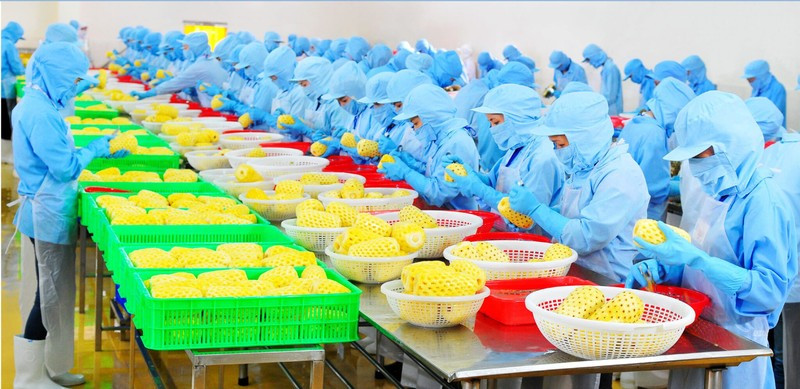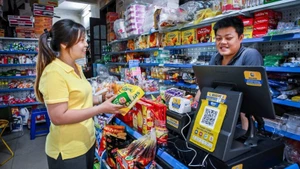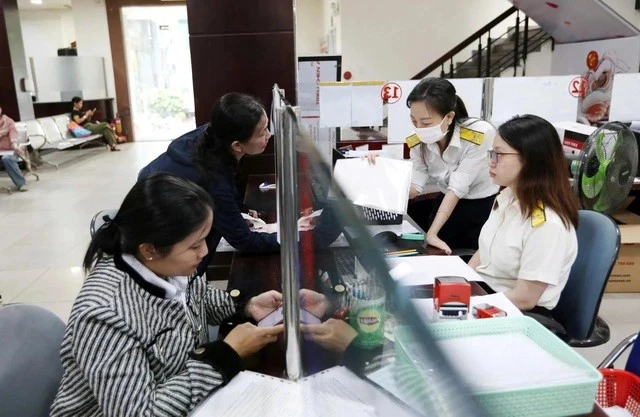Room for further development
Dang Phuc Nguyen, Secretary General of the Vietnam Fruit and Vegetable Association, said that as the world’s second-largest economy, with a population of 1.4 billion people, China has an increasing demand for fruits and vegetables with growth averaging at more than 10% per year.
Chinese consumers are now increasingly interested in clean and safe agricultural products and vegetables with natural origins and reasonable prices, which is a strength of Vietnamese fruits and vegetables. Additionally, trade agreements between Vietnam and China have helped reduce taxes and create favourable conditions for Vietnamese fruit and vegetable exports.
Many Vietnamese fruits such as durian, dragon fruit, banana, jackfruit, mango, passion fruit, and lychee are well-known and favoured by Chinese consumers thanks to their delicious taste and quality compared to neighbouring countries. Notably, the border gates between Vietnam and China are located very close to Chinese wholesale markets, an advantage exclusive to Vietnam, which significantly reduces transport time for fruits and vegetables from production sites to Chinese consumer markets, substantially lowering logistics costs compared to other countries.
During a recent trade promotion trip to China’s Guangxi, Cao Ba Dang Khoa, Secretary General of the Vietnam Coconut Association, shared that since the implementation of the protocol on phytosanitary requirements for fresh coconut exports from Vietnam to China, positive signals have emerged for the future of Vietnam’s coconut industry in this populous market. As a result, the continuous expansion of cooperation and the signing of large orders have led to many businesses not having enough products to meet export demands.
From the perspective of businesses, Nguyen Thi Thanh Thuc, General Director of AutoAgri Software Technology Corporation, shared that many Chinese vegetable seed corporations want to invest in Vietnam. This is a good opportunity for domestic businesses to learn about clear origin tracing, while also facilitating the process of official channel export negotiations.
Besides consuming fresh vegetables and fruits, China also has a large market for processed food products. Chinese merchants also control many large food distribution systems worldwide. Therefore, with cooperation mechanisms and preferential policies for businesses investing in production linkages, purchasing and processing fruits and vegetables in Vietnam, reducing storage costs, reducing losses, and preventing food waste, Vietnam still has much potential for official channel fruit and vegetable exports to China.
Strong competition with rivals
Although opportunities for official channel exports to China are opening up for Vietnamese businesses, Vietnamese products must compete with rivals from Thailand, Malaysia, Philippines, Cambodia, Australia, and some South American countries including Chile, Peru, and Ecuador. Some products like bananas, dragon fruit, lychee, longan, pomelo, ginger, and garlic must also compete with Chinese domestic products.
Additionally, China’s food safety standards are getting stricter, requiring Vietnamese businesses to update and meet these requirements. China’s regulations on food hygiene and animal and plant quarantine are quite complex and time-consuming. Vietnamese fruit and vegetable exports must have growing area codes inspected and issued by Chinese customs. Processing and packaging facilities must also register for codes issued by Chinese customs following strict inspection.
Moreover, finding customers and building distribution channels in China is also a significant challenge because most Vietnamese fruits and vegetables are sold to small Chinese traders concentrated along Vietnam’s northern border. Notably, Vietnamese businesses have not yet deeply penetrated China’s domestic market nor provinces in the northern regions.
Nguyen Thi Thanh Thuc said that her company is building an agricultural trading platform that integrates many advanced technologies to support tens of thousands of farming households, cooperatives, and businesses with origin tracing as required, thereby promoting official channel exports of Vietnamese fruits and vegetables to the Chinese market.
Nguyen Trung Kien, a specialist from the Asia-Africa Market Department under the Ministry of Industry and Trade, suggested that besides building and protecting their brands, businesses must comply with Chinese regulations on quality standards, testing - quarantine, and packaging traceability, and continue to invest in research and application of advanced technologies in production, processing, and product preservation.
Vietnamese exporters should particularly focus on exploiting business-to-business (B2B) and business-to-consumer (B2C) markets in China through e-commerce platforms. Additionally, to support the transition from informal to formal trade channels, local authorities need to change the habit of utilising border resident exchange for large-scale trading and address the risk of goods congestion during peak seasons to bring border resident exchange activities back to their original nature.
Nguyen noted that Vietnamese businesses need to make greater efforts in understanding China’s domestic fruit and vegetable production seasons to develop response measures or adjust Vietnam’s production and export schedules, avoiding competition for products like dragon fruit, bananas, mangoes, longan, lychee, and watermelon.
Businesses should invest in production and processing technology, apply international techniques and standards to improve product quality, ensure food safety and hygiene; and import or research advanced technologies for fruit and vegetable preservation and processing to create optimal conditions to extend the selling period for Vietnamese fruit and vegetable products.
Additionally, there is a need to build a good image for Vietnamese fruit and vegetable products in the Chinese market to gain the complete trust of Chinese consumers in the quality of Vietnamese produce through good production practices like VietGAP and GlobalGAP. Products must have attractive packaging, clear labelling, and easy-to-trace origins to create confidence for consumers.
In particular, businesses need to coordinate with Vietnamese trade offices in China to diversify products and expand markets, not just focusing on wholesale markets but also expanding to large supermarkets and markets further inland. Attention should be paid to exploring provinces and cities in northern China, and collaborating with Chinese businesses to jointly build supply chains and distribute Vietnamese fruit and vegetable exports to China in a mutually beneficial manner.
















